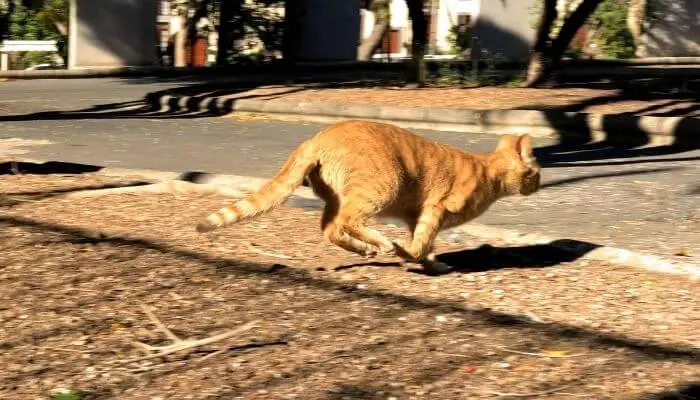Yes, cats can find their way home.
How long this takes will depend on how far away from home they wander.
Cats can perceive direction but it remains a mystery how they navigate their way across unfamiliar terrain to get themselves back home.
Theories include everything from magnetic geolocation to olfactory cues but experts aren’t sure which theory is correct.
Contents
Cats Tend To Stay Close To Home
Cats are natural wanderers, something that can cause anxiety to cat parents when letting them out for the first time.
Fortunately, cats have a good sense of direction and don’t tend to go too far away from their homes.

There have even been cases of cats travelling home after getting lost during a trip or house move.
The longest documented distance a lost cat has travelled to get home is around 200 miles.
This cat got lost while on a family holiday but managed to return home after 2 months.
Using Sights and Smells
When close to home your cat will create their own territory using scent.
Cats who spend time outside will also be able to understand surrounding territories quickly.
The territory is invisible to humans but is obvious to cats so just because you can’t see any obvious signs of your cat’s territory doesn’t mean they aren’t there.
According to VCA Hospitals, cats have between 45 – 80 million scent receptors (humans have 5 million).
Having such an excellent sense of smell means cats can pick up faint scents that may be able to help them find their way home.

Cats tend to roam a short distance when outside, with many not venturing more than a mile away from home.
Cats in largely populated areas tend to have a smaller territory as there are often a number of other cats in close proximity so it is safer to stay close to home.
Cats may also use recognisable landmarks to help them get around an area.
These could be natural landmarks such as rivers or trees or other landmarks such as big buildings.
All of this visual and olfactory information could be pieces of the puzzle that help a lost cat come home.
While there is limited research on cats homing abilities, there are many interesting studies about other animals and these could give us clues as to how cats can find their way.
Studies have revealed that some animals navigate by the stars, for example, nocturnal dung beetles can roll in a straight line only when the Milky Way is in view and captured seabirds can find their way home as long as the sun or stars are visible.
Maybe cats have similar navigation techniques when they are travelling across long distances.
Using Earth’s Magnetic Fields
One of the popular theories is that cats are able to sense the Earth’s magnetic field.
The presence of iron in the inner ears and skin of cats may act as a natural compass.
The iron helps the animal determine direction thanks to the natural magnetic fields in the ground.
Just as compass needles align with the Earth’s magnetic field, numerous animals can use this too so it is certainly possible cats do this as well.
Kenneth Lohmann, of the University of North Carolina, found that sea turtles are led by the magnetic fields and swim in the direction of their migration from hatching.
During experiments, the turtle swam the other way when they were put into a magnetic field that reversed north and south, showing that they are using Earth’s magnetism to direct them.
The newly hatched sea turtles orientate themselves based on the Earth’s magnetic fields and this is something that cats could be sensing too.
How Does A Cat Get Used To A New Area?
Cats explore new territories in a systematic way which allows them to create a map in their heads of the area.
This involves exploring in ever-increasing circles or rectangles until they are familiar with the area.
If a cat is lost, they may use a similar system that allows them to investigate the area until they either come across their own territory or detect familiar smells in the wind that they can use to get home.
What Do Cats Do When Away From Home?
If your cat hasn’t come home yet you may be worried about them.
If a cat is able to, it will find its way home and, as you can see, many factors help them do this.
It’s impossible to say how long it will take a lost cat to find its way home as there are so many variables to consider (e.g. how far away from home they wandered).
Researchers at the University of Georgia investigated to find out what cats are up to at night.
They put small cameras on 55 cats and studied the footage to discover 44% of the cats hunted wildlife during this time.

They also found that 25% ate or drank away from home.
This means it is unlikely your cat is going hungry if they have missed a meal at home.
There are of course dangerous behaviours that were witnessed too such as crossing roads, encountering strange cats and exploring small spaces.
So Why Do Cats Get Lost?
You may be wondering how a cat can get lost in the first place and how likely it is that your cat will lose their way.
Cats tend to stay close to home but at times they may have to run away from other cats, dogs or other potential dangers.

This may take the cat into unfamiliar areas or mean they end up further away from home than they had anticipated.
This can cause them to be lost and have to find their way back in a systematic way.
Finding their way back can take some time but the cat will eventually come across their territory or familiar areas and return home.
Fortunately, most cats don’t panic when lost and will still be able to sustain themselves by hunting as they figure out which way to go.
Helping Your Cat Find Their Way Home
There are a few things you can do to help your cat find their way back home.
You can’t control what your cat gets up to but these may help you keep an eye on them:
- First, you can microchip your cat and put an identification tag on their quick-release collar. Always make sure your information is up to date so you can be contacted if your cat is found by someone else.
- Secondly, you can spay or neuter your cat. This will prevent unwanted pregnancies and prevent your cat from roaming too far. It will also help reduce interactions with unfamiliar cats.
- Put a cat tracker on your cat. This way you can always check and see where they are in real-time. This is very helpful if your cat hasn’t come back for dinner or they are away longer than usual. A cat tracker is a simple tool that can give owners peace of mind.
- Another option is to keep your cat indoors. Many cats love to roam and will do their best to find a way out of the house so doors and windows need to be kept secured. If you are keeping your cat indoors you could make your garden escape-proof or give them a secure outdoor area where they can still enjoy time outside without the risk of getting lost.
As an Amazon Associate I may earn a small fee from qualifying purchases at no extra cost to you. This helps us run the site, so thanks for your support!








Leave a Comment